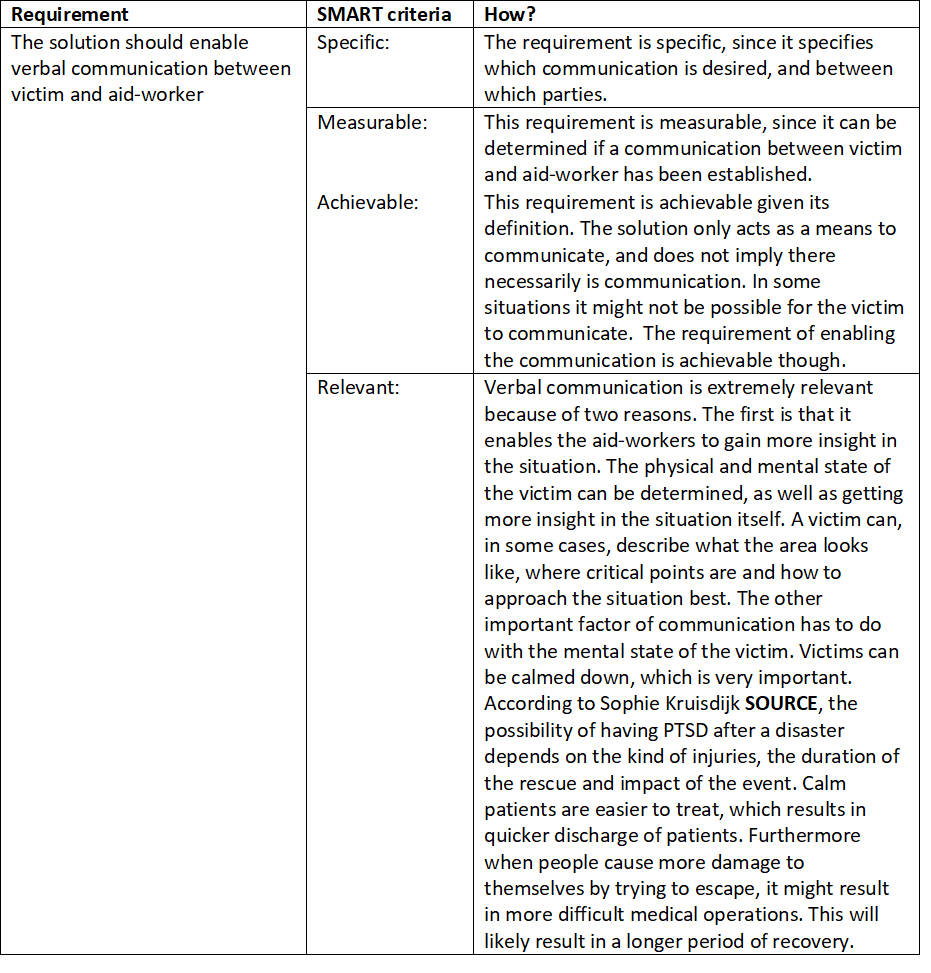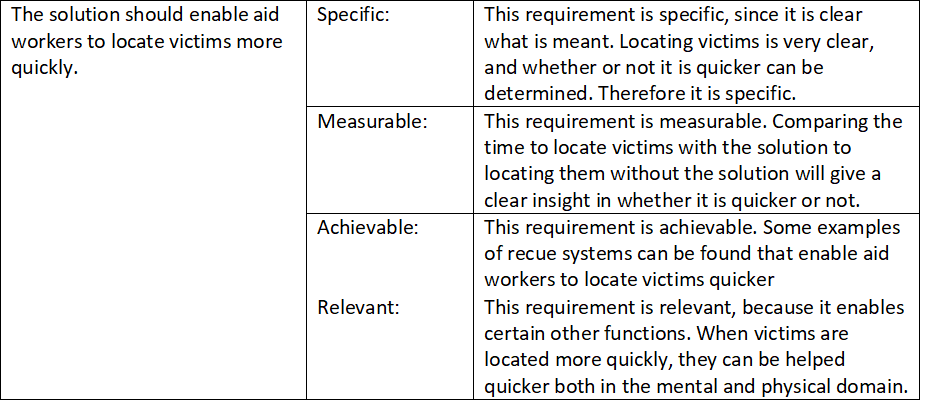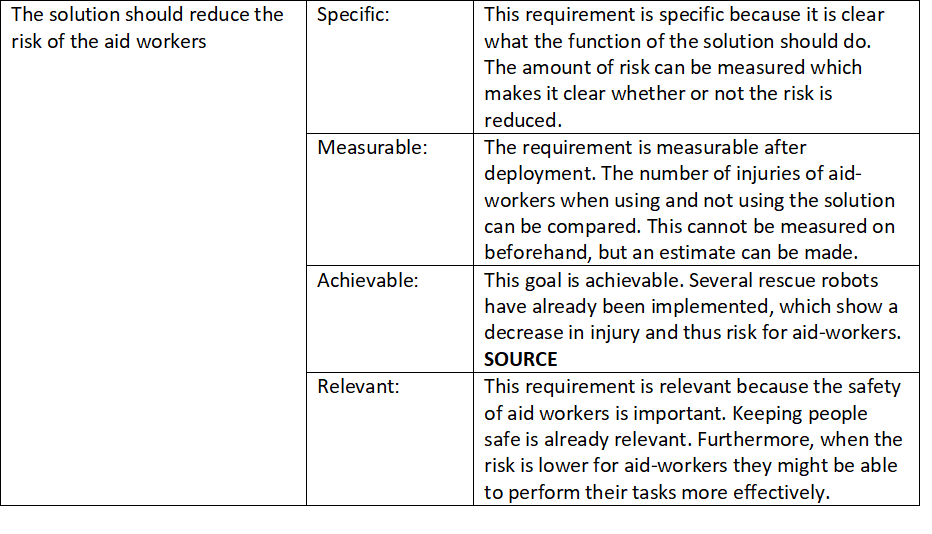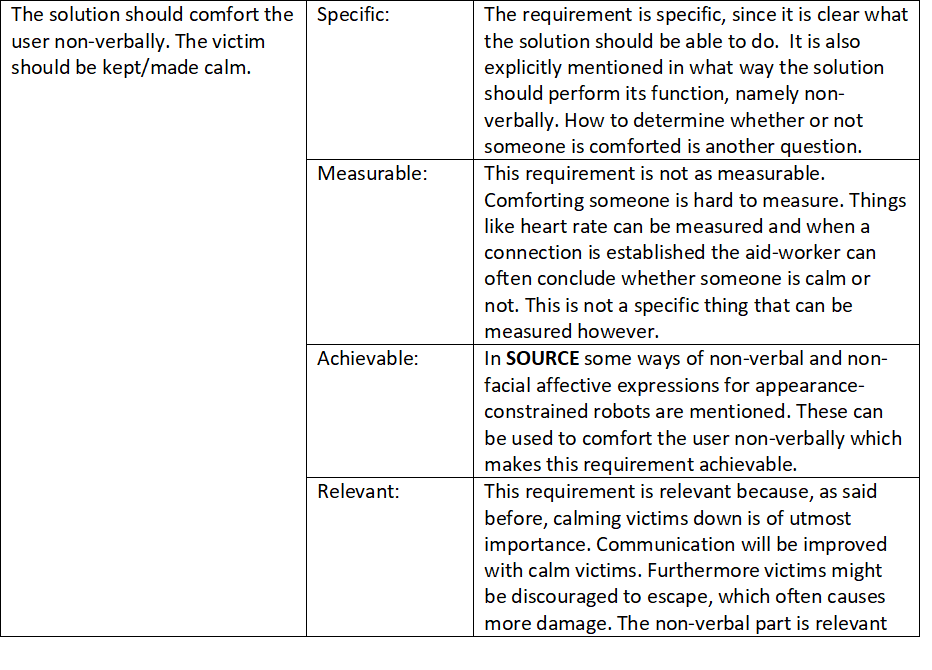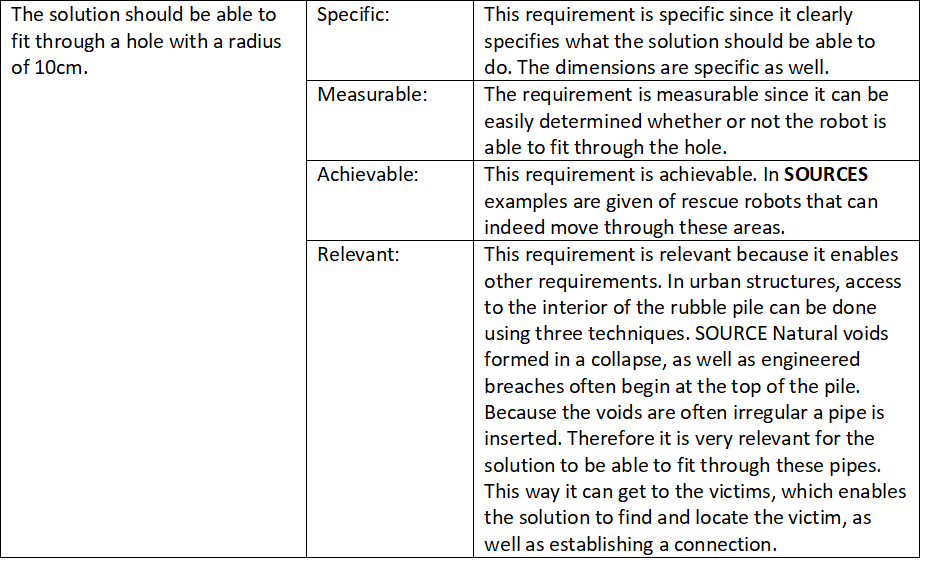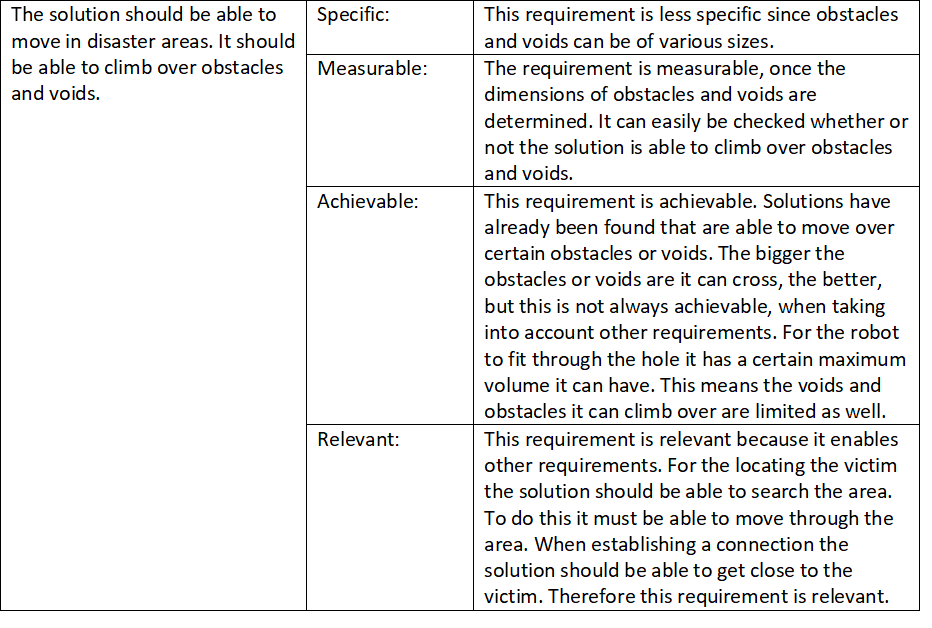R4: Difference between revisions
No edit summary |
|||
| Line 10: | Line 10: | ||
===Project Goal=== | ===Project Goal=== | ||
... | We ontwerpen een robot gebaseerd op richtlijnen uit ons onderzoek naar geruststellend effect op slachtoffers in rampen. Het geruststellen effect willen we bereiken via non-verbale communicatie zoals licht, benadering van het slachtoffer en uiterlijk. Bovendien speelt het tot stand brengen van audio communicatie ook een rol. | ||
==Approach, milestones and deliverables== | ==Approach, milestones and deliverables== | ||
Revision as of 22:29, 17 March 2019
Reassuring Rolling Rescue Robot
Back to PRE2018 3 Group8
To the weekly notes
Introduction
Problem statement
On January the 27th, a building in The Hague exploded due to gas leak. It took the aid workers eight hours to save all residents. Sharwin, who was one of the residents, got stuck underneath his bed. Fireman Arie van Doorijweert mentioned that in the beginning they could only communicate with Sharwin by shouting (1). The time it takes to localize the victims and to remove the rubble is of great importance for the health of the victims. For aid workers it is necessary to know the specific situation of the victims, so that a personal approach can be made for the rescue. However, often there is no communication in disaster areas between aid workers and victims. This makes it harder for aid workers to estimate the critical situation, because they do not posses enough information to act upon. Victims can be helped quicker and more precise if aid workers would have access to the information of the victims themselves.
Project Goal
We ontwerpen een robot gebaseerd op richtlijnen uit ons onderzoek naar geruststellend effect op slachtoffers in rampen. Het geruststellen effect willen we bereiken via non-verbale communicatie zoals licht, benadering van het slachtoffer en uiterlijk. Bovendien speelt het tot stand brengen van audio communicatie ook een rol.
Approach, milestones and deliverables
Approach
To tackle this project, we started with extensive research on the state of the art. This is done by examining the current literature on the subject. These examined papers outline the current state of the problem, solutions to these problems, and their flaws.
After obtaining a better view on the problem at hand, the USE (user, society and enterprise) aspects are analyzed, to determine why this problem is relevant. These three aspects should always be kept in mind during each stage of the project. These aspects may sometimes ask for different solutions to the same problem, so they must be analyzed to determine which aspect should be taken into account more, and compromises must be made. Also different subproblems may ask for different USE aspects, but two solutions from two subproblems may not always be able to be combined, meaning that choices must be made.
After having analyzed the USE aspects, a scenario will be made where the robot shows of its capabilities, and multiple persona’s will also be made who come into contact with the robot. Research has also been done about the interaction between rescue robots and the human victims. These papers will be used and important factors for the product to have will be determined.
During the whole process, a report will be written in which the process is outlined in a more detailed manner, and which also follows our progress. This report will also more finely describe the problem and the solutions. Because this is done alongside the creation of the actual prototype, planning is important again. Some people will be working on the product and some on the report. This also means clear communication is of utmost importance. Alongside each progress meeting, the group will come together once or twice a week to discuss what has already been done and what should still be worked on. This way it will become clear if the goals will be reached in time and the project is on track.
After all this is done a presentation will be prepared and presented, the wiki will be completed, and all deliverables will be handed in.
Milestones
- Decide on subject (06/02/19)
- Formulate problem statement (11/02/19)
- Finish literature study (11/03/19)
- Finish sketches of product (13/03/19)
- Finish design of product (18/03/19)
- Present product
- Finalize the wiki
Deliverables
- Wiki (report)
- Final presentation
- 3D computer design of the robot
Planning
| Week 1 | Literature study (Gialesi, Lotte, Mark, Noor, Romy) | Problem statement (Everybody) | Define users and user needs (Everybody) | Make planning (Noor) | Update Wiki (Every-body) | |||||
|---|---|---|---|---|---|---|---|---|---|---|
| Week 2 | Communication (Gialesi, Noor) | Walking (Mark, Gialesi) | Approach Victim (Romy, Lotte) | Hue of light (Gialesi, Noor) | Looks (Mark, Noor, Romy) | Scenario & persona (Lotte) | Analyze USE aspects (Romy) | |||
| Week 3 | Scenario and persona (Lotte) | Define requirements and objectives (Everybdoy) | ||||||||
| Week 4 | Research face (Noor, Romy) | Research Locomotion (Gialesi, Lotte) | Refine requirements (Mark) | |||||||
| Week 5 (Carnaval) | ||||||||||
| Week 6 | Redefine project goal (Everybody) | Make sketch of the robot (Everybody) | ||||||||
| Week 7 | Make computer sketch (Mark) | Summarize the research conclusions (Gialesi, Romy) | Explain use of screen (Noor) | Prepare presentation (text and powerpoint) (Lotte) | ||||||
| Week 8 | Finalize wiki (Everybody) | |||||||||
| Week 9 | Presentation | Hand in deliverables | ||||||||
Who's doing what?
- Lotte Hollander: writing report + wiki, graphic design, prototyping
- Romy Lauwers: writing report + wiki, literature, photoshop
- Mark Wijnands: mechanics, control, 3D design
- Noor Schroen: literature, electronics
- Gialesi Notkamp: literature, electronics
User Study
Users and User Needs
Primary users
Aid Workers
They search for victims and provide medical help on site. They actually use the robot in the field.
Needs
- Accurate estimated number of victims
- Localize victims more quickly
- Safety while trying to search for survivors/victims
- More data about the situation in critical conditions
- Personal/medical information of the victims
- Easy and fluent communication with victims during the rescue
Victims
Victims of a post-disaster area. They interact with the rescue robot.
Needs
- Less mental issues after the disaster
- Receive medical aid as fast as possible
- Safety
- Communication with a professional aid worker
- Recognize help
- Reassurance of help
Secondary users
Volunteers
Family members, friends, neighbours and others who help with the search.
Needs
- Safety while trying to search for survivors/victims.
Non-profit organisations
Non-profit organisations, e.g. the Red Cross, can give workshops/education about the use of the robot.
Needs
- Safety
- More volunteers
Tertiary users
Government
The government finances the search and rescue.
Needs
- Lower (medical) costs
- Less casualties
Hospitals
Hospitals where the victims are hospitalized. They need to buy the device once but then they will take advantage for longer. They are able to use the device for a long period.
Needs
- Less mental issues after the disaster
- Less casualties
- Quicker discharge of patients
Production companies
It's able for the companies to get more brand awareness when they will produce (a part of) the device. Other less known products of them, that are maybe very good in combination with the device, could get more publicity, which is also a positive impact.
Needs
- More brand awareness
Requirements
| Requirement | SMART criteria | How? |
|---|---|---|
| hier komt dan de requirement | Specific | uitleg jnngan faw fjwevjawgh u fhawjghwe ga afweohgau ghajgeuhguie nfweahuweg hgaweo |
| Measurable | uitleg | |
| Achievable | uitleg | |
| Relevant | uitleg |
These requirements should be completed within a time period of one quartile. The 1st, 6th, 7th, and 8th requirement will be further taken into account because we wanted to focus upon the psychological effect of a natural disaster rescue robot on the victims.
Research
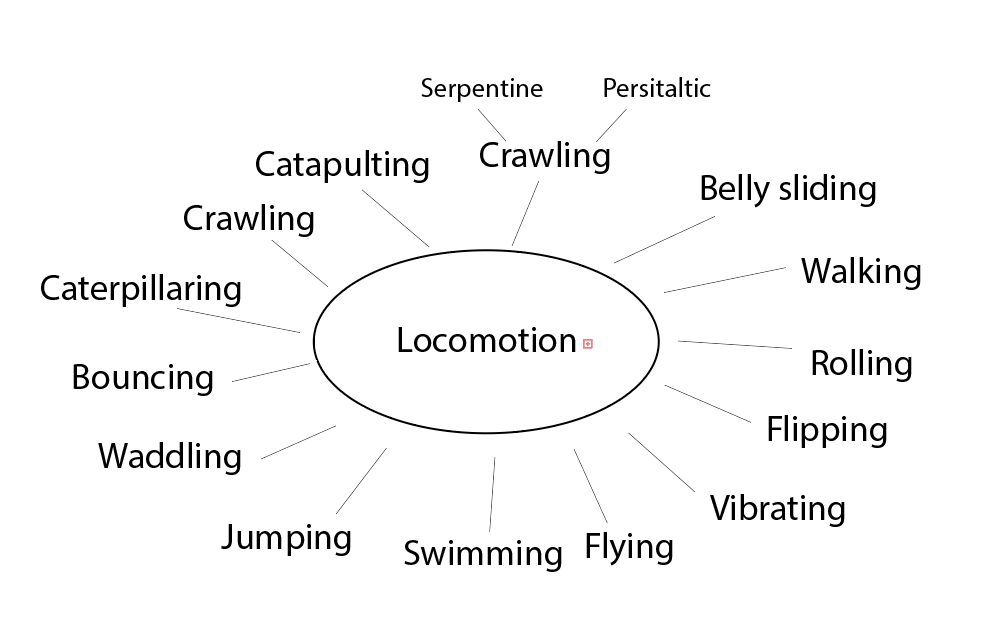

During the brainstorm session we discussed possibilities for the design of the robot. We considered the (body)shape, face and locomotion. In the following figures the outcome of the brainstorm can be seen. We eventually decided that the shape is largly depended on the locomotion and face. Therefore we decided to choose five options for the face and locomotion to further conduct literature study. The findings are shown below.
Face
The following part discusses the external features of the robot. Should the robot have a face? If so, how should that face be executed? To start off, the possible options have been narrowed down to four possibilities. The robot could either have a realistic human- or animal-like face, an unrealistic face, no face at all, or it could have a screen where the face of the aid worker commandeering the robot is shown.
Realistic face
A realistic face is a face that closely resembles that of a human or an animal. An animal face would be preferable to a human face in the case that the body of the robot resembles an animal.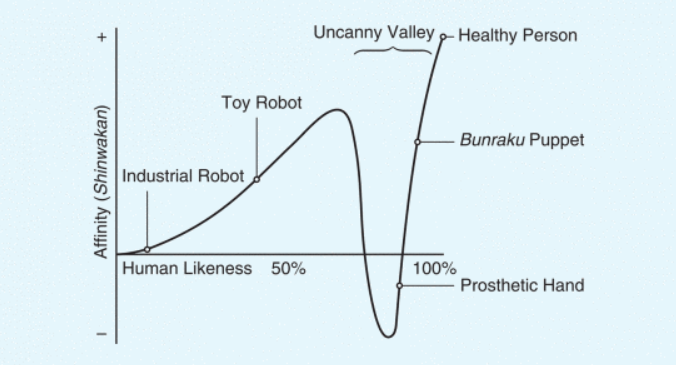
The robot needs to convey empathy, and humans and animals are adept at doing exactly that, for that reason, using a realistic face makes sense.
However, there is one problem with trying to use a realistic face, and that can be described using the term ‘uncanny valley’. Uncanny valley is the term used for object that bear close resemblance to humans, but bring a feeling of discomfort with them. This term was invented by robotics professor Masahiro Mori. His original hypothesis states that as the appearance of a robot becomes more human-like, observers' emotional response to the robot becomes increasingly positive and empathetic, until it reaches a point beyond which the response quickly becomes strong revulsion. However, as the robot's appearance continues to become less distinguishable from a human being, the emotional response becomes positive once again and approaches human-to-human empathy levels. [1]
In order to convey the desired empathy using a realistic face, it is necessary that this face doesn’t end up in the uncanny valley. Getting all the features just right, however, would be really hard, and would take a tremendous amount of effort.
Unrealistic face
It would be easier to fabricate a robot with a less human appearance, that would still get a positive emotional response from humans. This is represented by the peak in figure []. This would take considerably less effort, time and money, while still yielding similar results.
Screen/aid worker as face
A study has been done to investigate how robot facial appearance affected perceptions of the robot’s personality, mind and how scary the robot is. Participants rated the robot on these three characteristics.
The interaction with the human and robot were done under three different condition in a random order. The robot had a display with either a humanlike face, a silver face or no-face on it.
The results of this study show that the display with the humanlike face was most preferred. Participants state then the robot having most mind, being most human-like, alive, sociable and amiable. The silver face display was least preferred, because it was most spooky, moderate in human-likeness, mind and amiability. The robot with no-face display, so there was nothing displayed on the screen, was rated least sociable and amiable.
These results suggest that the more humanlike a healthcare robot’s face display is, the more people are positive about it. Scariness was related to negative impressions. [2]
In our case, the display could have the face of the aid-worker on it. However it would be a live view with communication and not a programmed display. This could be positive, because then it is less eerie and people are more inclined to accept help.
No face on display
As can be read above, a no-face display was rated as least sociable and amiable. However there was nothing mentioned about eeriness.
Nothing at all
Without any face the robot would be anonymous. This would influence the perception of the robot. [3] Robots should be more machine-like than human-like according to Oestreicher. They should be easy to use and be safe and reliable. Furthermore in the a study of ROBOCARE Domestic Environment, where the robot interacts with elderly in different scenarios, results showed that the robot without a face was preferred. Also, according to research done by Jamy Li and Mark Chignell on communication of emotion in robots through head and arm movements [5], head and arm movements suffice to convey emotion.
Conclusion
After carefully examining all the options, a robot having a display with the face of the aid worker on it was deemed to be the best option. On the display a live view of the aid worker will be shown, because that is less eerie than a preprogrammed face. Furthermore a study has shown that a robot with a face seems to be more human-like and sociable. This can be considered as an import aspect, because of the non-verbal requirement.
Locomotion
The following five ways of robot moving are juxtaposed for their applicability in our design. These options are analysed based on the ease of moving over a post-disaster terrain and the behavioural effect when approaching a victim. The order in which these locomotions are discussed is randomly.
Flying
The complexity of handling uneven terrain means ground robots are tougher to engineer, than robots moving through sea and air. Plane-like flying is also considered as one of the easiest way of moving, because the sky mostly obstacle-free and the step from remote-control plane to flying robots is relatively small. [1] Research on these plane-like flying drones and insect-like flying drones is not developed enough. Because there is too little research and thus too little information about these drones, this locomotion will not be chosen for the design of the rescue robot.
Crawling (serpentine or peristaltic movement)
Serpentine and peristaltic are two alternative ways of robot locomotion that focuses on rectilinear motion.
Serpentine motion is based on the forward movement on a snake which uses ground points in order to push their body forward. The small cross-section and low center of gravity of most biological snakes, coupled with their large repertoire of possible motion sequences, make their bodies very efficient when navigating confined spaces and rough terrains. However, the artificial snakes are generally slow and most (especially those with wheels) are not well suited for travel over rough terrain. This serpentine motion is already being tested by Carnegie Mellon University in a real search and rescue. Even though the robot did not find any victims the Mexican Red Cross workers said that “The robot performed well” and added to that, “they would like to have a similar tool in the future”
Peristaltic crawling is copied from earthworms which propagates a longitudinal wave from the front of the body to the back by varying the thickness and length of its segments. This way, the object can move while keeping a large area in contact with the ground. Therefore, it has the following benefits: 1) The amount of space required by this locomotion mechanism is less than that of others such as bipedal, wheel-based and meandering locomotion, 2) The locomotion mechanism is likely to have stability on irregular ground and inside a narrow pipe. Therefore, it is desirable to apply this mechanism to rescue robots and limited environment exploration robots
Walking
When considering a walking robot for an uneven terrain, the robot should have at least four legs for dynamic stability. By adding more legs, the platform becomes wider and more stable. However, more legs also comes with more moving parts, which require better coordination [1]. Six legged robots are the most stable and popular legged locomotion concept. The walking technique of legged robot is always a challenging task for the researchers. Pre-programmed robots can never successfully interact with the environment autonomously because they have to be reprogrammed for different environments. Hence, a self-learning technique must be incorporated to make the robot learn things as per its interaction with the outside environment. [2]
Flipping
Body-flipping locomotion is achieved by active flipping of the robot’s body. The benefit of this type of motion is that it is fast and the movement can be predicted efficiently. However, flipping locomotion in robotics has so far only be tested on stairs and not in post-disaster areas. Also, the robot needs more space while flipping than a robot has more contact with the ground. Therefore, it will probably not be suitable as a rescue robot.
Rolling (wheels)
Rolling is the easiest and most common way of robot locomotion, e.g. cars and iRobot [1]. The main reasons for this are their easy controlling, stability and simple mechanical design. Wheeled locomotion is preferred over other modes of locomotion due to their power efficiency, faster running capability but traction on rough terrain, its control and stability are their primes areas of concern. For static and dynamic stability, the robot should have three wheels. Controllability of wheels becomes harder when the maneuverability of the wheels increases. This is because an small error (e.g. change in speed) can cause a robot to deviate from its path and make it difficult to control. However, maneuverability is important for a multi-terrain robot in order to move swiftly in any direction on the ground. Omnidirectional powered wheels are used which enhance the maneuverability in multi-terrain environments [2].
Conclusion
When considering the suitability of robot motion in disaster areas and its size limitations, rolling is the most fitting design choice. This locomotion fits the requirement that it should be able to climb over obstacles and voids. Also the requirement of size can be achieved using this locomotion. Furthermore a robot with this locomotion is easy to control and has high maneuverability and dynamic stability.
Communication
Audio
In order to establish verbal communication between victim and aid worker, audio is needed. On the robot this will consist of a microphone and a speaker which are both wirelessly connected to a unit at another place where the aid worker is. So, the audio system will be almost like a phone connection between the victim and the aid worker. To save power, these are remotely turned on and off by the aid worker. How this wireless system works exactly, is unknown at the moment, because this is currently beyond our capabilities.
The victim will talk with an aid worker and not with the robot itself because programming a robot to include speech recognition and speech is extremely hard. Also, with the current state of the art, robot voices are pretty monotone. They don’t convey a lot of emotion or empathy, which is desirable in cases where the robot will be working. Of course, we could work on making a non-robotic sounding voice for the robot, but this is not the goal of this project. A human however, can convey empathy even with only their voice. This is confirmed by the fact that for a really long time, and still, psychoanalytic sessions take place over the phone for some people due to personal circumstances (35). According to Leffert (36), he had nine analyses in which he found that telephone sessions were indistinguishable from in‐person sessions, but he did not support his findings with detailed process. (Psycho)therapists must have a deep understanding of empathy to be able to talk with their patients. If telephone sessions can be as effective as in-person sessions, that means that therapists (and other people), can also convey a certain level of emotion and empathy over the phone, which is needed to calm down victims.
Colour of light
When the robot moves towards the patient in the dark environment under the rubble, this can be quite stressful for the patient. The robot would most likely not be completely silent when moving. To make the patient ready for what approaches him/her the robot could emit a light, making its form visible. Additionally, when considering the requirement about non-verbally calming the victim, it is proven that light can influence the emotional state of a person. As shown by multiple researches, the colour green and blue are mostly associated with the emotions peaceful and calming. If the robot would emit a light in one of these colours this could already help the patient to calm down.
Approach of Person
The psychological study of how people establish mutual distances in communication is called proxemics. However, this study might not be applicable to robot-human communication. When a robot approaches a human, several considerations should be encountered in the way of approaching. (1) Personal Space: a social convention that defines a region of space around individuals as personal, (2) Direction of Encounter: the preferred direction from which a person would like to be addressed, (3) Feasibility of interaction: the region of space where interaction is feasible.
In the thesis ‘Approaching Independent Living with Robots’ by Elena Torta, these three positions are tested and evaluated for a sitting and standing positions of the test subjects. The results concluded a best mutual distance between 140-200 cm. Also, the central direction of encounter was preferred most. The experiments were conducted with the Nao robot and only encounter sitting and standing positions. However, in our scenario it is also possible that the victims are lying down and have less freedom of movement. Also, the appearance of the robot is different. Therefore, a new test should be conducted to determine the best approach with our designed robot.
Design
...
Appendix 1
Sarah Janssen

Name Sarah Janssen
Age 38
Work chief fire officer
Family married and two children, Jimmy (5) and Lisa (7)
Sarah is a devoted wife and mother, and works forty hours per week at the fire department. Besides combating fires and helping evacuees to safety, her job is to oversee the delivery of emergency services to accident scenes and burn sites. She is continuously working on improving the emergency services delivery for a quicker response time and rescue.
Frustrations
- Estimation of the number of victims is not accurate
- Evaluation of the victims’ personal situation in a disaster area is based on limited information
- Communicating with victims during the rescue is difficult
Goal
A way of communicating with the victims in a post-disaster area to gain information about their health and position for a more efficient and safe rescue.
Steve Clinton

Name Steve Clinton
Age 53
Work real estate investor
Town Tampa, Florida, USA
Steve lives together with his wife Daisy and his 7-year-old son William. His family evacuated to their family in South Carolina when the Hurricane Irma arrived in 2017. Steve stayed home, which got destroyed, and he got stuck under the rubble. Luckily, professional aid workers saved Steve after 10 hours and Steve survived the natural disaster. While looking back at the event, there are some things that he would have done differently if he could.
Frustrations
- The feeling of helplessness, because he could not contribute to his rescue
- The feeling of anxiousness, because he did not know when he would be found and how long the rescue would take
- Fear that the event might repeat itself
Scenario
An earthquake of Richter magnitude 5 has caused the collapsing of a building. It is estimated that at the time of the collision, six people were inside. Sarah coordinates the rescue teams and rapidly has to decide how to rescue these people. With the help of Spidey Sense, she is able to virtually reach the victims and communicate on their personal situations. She can calm the victim by telling them help is on their way and analyse their situation based on the information provided. This way, Sarah knows the health conditions of the victims and how to remove the rubble, and can therefore bring everyone in safety more efficiently.
References
[1] Newspaper article on gasexplosion in The Hague
[2] Scientific bout the approach of the victim <- Is much 'goeie'
State-of-the-Art
Spider Robot and Motion
[3] This paper looks at certain safe points where the spider robot can place its feet and where not in a plane.
[4] This paper looks at certain points where the spider can and cannot place its feet.
[5] This paper looks at a spider robot that climbs autonomously in pipelines. Could be useful for the small spaces.
[6] This paper is about the capabilities of the spider and studies the foot force and torque distribution of the spider in different conditions and compares the leg configurations in order to minimize the torque effort.
[7] This paper discusses foot designs and fabrication for use with a spider-inspired climbing robot.
[8] This paper is about a four-legged spider robot that learns how to move in its environment and reacts to physical changes.
[9] This article discusses a dragline-forming robot inspired by spiders
[10] This is the site of Robugtix. This company has a small spider robot, which can make smooth, life-like motions. The toy comes equipped with a 3D printed body, 26 motors, and microcontroller board pre-loaded with the Bigfoot™ Inverse Kinematics Engine.
[11] This paper focusses on a spider-imitated robot used for rescue
Relevant Rescue Robots
[12] This paper is about a rescue robot with debris opening function
[13] This paper is about MOIRA the Mobile Inspection robot for Rescue Activities.
[14] This paper is about a robot that can move the debris.
[15] This patent is about an all-terrain rescue and disaster-relief robot.
[16] This paper discusses an aerial search and rescue robot and its application to a specific earthquake.
[17] This paper is about modular, reconfigurable rescue robots.
[18] This article describes a so called WALK-MAN robot in post-earthquake scenario's.
[19] This patent is for an autonomous detection system and method of rescue robot in disaster area for complex environment
[20] This patent is for a full topography intelligence rescue robot with self-balancing objective table
[21] This patent is about an emergency relief goods transporting robot
[22] This article presents several different types of robots that can be easily deployed in rescue operations
[23] This chapter summarizes the status of rescue robotics
Disaster Rescue
[24] This patent focusses on a method for priority evaluation for robots under disaster rescue environment
[25] This article is about a challenge that aims to accelerate the development of robots that can help humans, not only with nuclear emergencies but also with fires, floods, earthquakes, chemical spills, and other kinds of natural and man-made disasters.
[26] This patent is about video search and a rescue robot based on ZigBee wireless positioning and search and rescue method
[27] This article discusses a simulation project for disaster rescue
[28] This article discusses disaster robotics and different ways of reaching victims.
Rescue robot interaction
[29] This paper provides a short tutorial on how robots are currently used in urban search and rescue and discusses some robot-human interaction issues encountered over the past eight years.
[30] This paper talks about non-facial and non-verbal affective expressions for appearance-constrained robots.
[31] This paper presents findings from field trials observing human-robot interaction between certified rescue workers and two types of tactical mobile robots at a rescue training site.
[32] In this article the influence of personal traits of a person on the approach distances of robots is discussed.
Prototypes of a spider robot
[33] This paper is about a high tech spider prototype, mady by reseachers of the Fraunhofer Institute for Manufacturing Engineering and Automation IPA. The prototype will provide emergency responders with an image of the situation on the ground, along with any data about poisonous substances. Future plans envision its use as an exploratory tool in environments that are too hazardous for humans, or too difficult to get to. Furthermore, the prototype is very cheap to produce.
[34] This site has an instruction guide to print 3D parts of a spider robot with four legs. It is possible to place an arduino in the middle of the design.
[35] This patent is for a novel rescue robot that can efficiently walk in a complex post-disaster area through a design of a spider-like structure
Robots with interesting factors
[36] This robot is portable and foldable and quickly carried in a backpack to a site where inspection, exploration, search and rescue, and other tasks are required to performed.
Regulation
[37] Regulation and entrainment in human-robot interaction
Communication
[38] Clinical issues in analyses over the telephone and the internet
[39] Analysis and Psychotherapy by Telephone: Twenty Years of Clinical Experience
